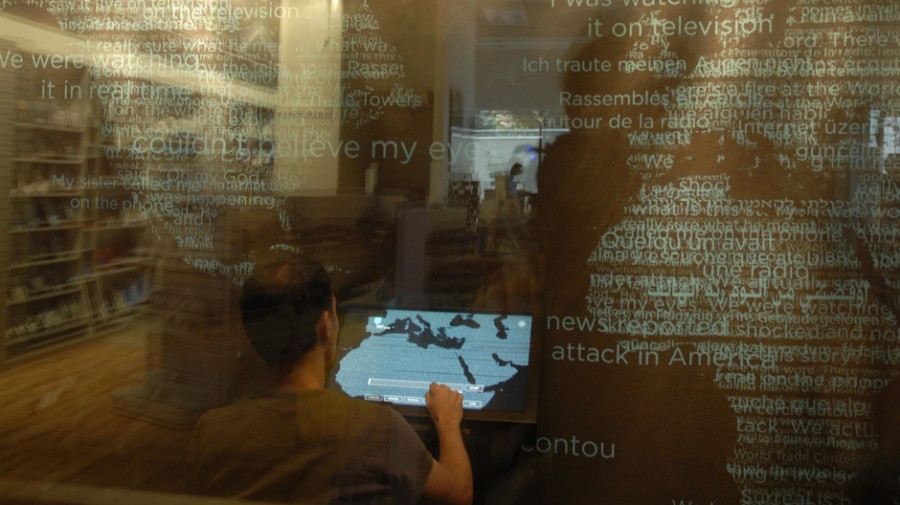By Elizabeth Alton Entertainmentdesigner.com

Visitor to museum uses technology Image credits: Local Projects, 9/11 Museum Site
On September 11, 2001, terrorist attacks on US soil rocked the nation. Now, more than 12 years after the event, the recently opened 9/11 memorial and museum has been erected at ground zero in New York to help us remember the individuals and families affected that day. It also helps make sense of the terrible tragedy from a cultural and human perspective. The team behind bringing the museum to life, which included Thinc Design and Local Projects, used an innovative approach to both storytelling and technology to bring these events alive and help interpret them for a broad audience.
One of the most moving aspects of the museum’s programming is its registries program. There are three 9/11 Memorial Registries: the Rescue and Recovery Workers Registry, which features details about rescue workers; the Witnesses and Survivors Registry, including stories from Manhattan and the Pentagon; and the Memorials Registry, a map of 9/11 memorials around the globe. Each registry can be accessed online and physically via touch screen in the museum.
The museum was awarded an honorable mention in the 2014 MUSE Awards by the American Alliance of Museums for their work in building digital communities. The awards committee had the following to say about the museum’s Registries efforts: “This project has the potential of, at long last, connecting and uniting people dispersed around the globe around a tragedy that has affected us all. I was particularly impressed with the varying levels of access and participation available, especially as related to the privacy and confidentiality some users may desire. I look forward to continuing to watch the Registries as they grow and evolve.”
The technology behind the museum has been eight years in the making, and includes a wide variety of touch screens, recording booths, and projectors. A series of over 90 multimedia installations introduces visitors to the events of that day, the stories of the victims and their families, the first responders, and the community of individuals around the world that were affected in some way.
The museum isn’t just about getting people to see the stories of others. There’s a much deeper personalization at play. It’s also a highly interactive concept, where visitors’ own stories become part of the exhibition. In press interviews, Jake Barton of Local Projects has eloquently stated, “This is a museum of visitor stories.”
There are numerous technologies at work in the museum, which help to both increase engagement and develop a meaningful experience for visitors. There are thousands of artifacts housed at the museum, including pictures, audio recordings, and the narratives of survivors. One column that was standing amidst the rubble – the only remaining standing column – is on display in the museum’s foyer. A touch screen wall allows guests to examine each of the scars and markings on the wall and understand the stories behind them.
Guests are invited to handwrite notes and their home cities in a digital guest book that projects their messages onto a large projection screen overlaid with a map that helps lend perspective to how wide the impact of 9/11 was. Audio and video recording booths ask guests a series of questions, including where they were on 9/11, and then collectively curates their answers. Through the strategic use of technology, guests are drawn in and the memorial’s impact and reach is greatly expanded.
Today, the memorial offers a number of online experiences including an interactive 9/11 timeline, the global Make History website where anyone can share their stories, a chance to explore the iconic Lady Liberty statue, and the Explore 9/11 iPhone app.
In terms of exhibit and event design, we often think of technology as a way to bring guests closer to the vast amount of information that exists about a given collection. It’s a tool that lets a visitor self-select where they want to dive deeper. The result at the 9/11 museum is different and deeply moving. It does help guests navigate the vast amount of information on one of the most recorded events in history. But it’s also a tool for creating a deeply inclusive experience, and for enabling a meaningful and educational experience for a wide audience that’s focused on a topic that still carries powerful emotional resonance today.

